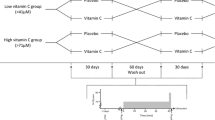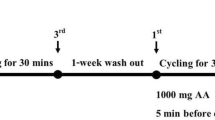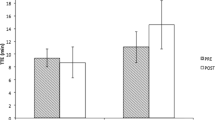Abstract
The purpose of this study was to evaluate the effects of β-alanine supplementation on markers of oxidative stress. Twenty-four women (age: 21.7 ± 2.1 years; VO2max: 2.6 ± 0.3 l min−1) were randomly assigned, in a double-blind fashion, to a β-alanine (BA, 2 × 800 mg tablets, 3× daily; CarnoSyn®; n = 13) or placebo (PL, 2 × 800 mg maltodextrin tablets, 3× daily; n = 11) group. A graded oxygen consumption test (VO2max) was performed to evaluate VO2max, time to exhaustion, ventilatory threshold and establish peak velocity (PV). A 40-min treadmill run was used to induce oxidative stress. Total antioxidant capacity, superoxide dismutase, 8-isoprostane (8ISO) and reduced glutathione were measured. Heart rate and ratings of perceived exertion were recorded during the 40 min run. Separate three- [4 × 2 × 2; acute (base vs. IP vs. 2 vs. 4 h) × chronic (pre- vs. post-) × treatment (BA vs. PL)] and two- [2 × 2; time (pre-supplement vs. post-supplement) × treatment (BA vs. PL)] way ANOVAs were used for analyses. There was a significant increase in VO2max (p = 0.009), independent of treatment, with no significant changes in TTE (p = 0.074) or VT (p = 0.344). Ratings of perceived exertion values were significantly improved from pre- to post-supplementation for the BA group only at 40 min (p = 0.02). The ANOVA model demonstrated no significant treatment effects on oxidative stress. The chronic effects of BA supplementation demonstrated little antioxidant potential, in women, and little influence on aerobic performance assessments.






Similar content being viewed by others
References
Abe H (2000) Role of histidine-related compounds as intracellular proton buffering constituents in vertebrate muscle. Biochemistry 65(7):757–765
Alessio HM (1993) Exercise-induced oxidative stress. Med Sci Sports Exerc 25(2):218–224
Artioli GG, Gualano B, Smith A, Stout J, Lancha AH Jr (2010) Role of beta-alanine supplementation on muscle carnosine and exercise performance. Med Sci Sports Exerc 42(6):1162–1173. doi:10.1249/MSS.0b013e3181
Baguet A, Reyngoudt H, Pottier A, Everaert I, Callens S, Achten E, Derave W (2009) Carnosine loading and washout in human skeletal muscles. J Appl Physiol 106(3):837–842
Bate-Smith EC (1938) The buffering of muscle in rigor: protein, phosphate and carnosine. J Physiol 92:336–343
Batterham AM, Hopkins WG (2006) Making meaningful inferences about magnitudes. Int J Sports Physiol Perform 1(1):50–57
Bloomer RJ, Falvo MJ, Fry AC, Schilling BK, Smith WA, Moore CA (2006a) Oxidative stress response in trained men following repeated squats or sprints. Med Sci Sports Exerc 38(8):1436–1442
Bloomer RJ, Goldfarb AH, McKenzie MJ (2006b) Oxidative stress response to aerobic exercise: comparison of antioxidant supplements. Med Sci Sports Exerc 38(6):1098–1105
Boldyrev AA, Severin SE (1990) The histidine-containing dipeptides, carnosine and anserine: distribution, properties and biological significance. Adv Enzym Regul 30:175–194
Boldyrev AA, Dupin AM, Bunin A, Babizhaev MA, Severin SE (1987) The antioxidative properties of carnosine, a natural histidine containing dipeptide. Biochem Int 15(6):1105–1113
Boldyrev A, Leotsakos A, Quinn P (1992) The effect of membrane stabilizing agents on Ca-pump of the sarcoplasmic reticulum. Ukr Biokhim Zh 64(6):54–58
Boldyrev AA, Stvolinsky SL, Tyulina OV, Koshelev VB, Hori N, Carpenter DO (1997) Biochemical and physiological evidence that carnosine is an endogenous neuroprotector against free radicals. Cell Mol Neurobiol 17(2):259–271
Boldyrev A, Song R, Lawrence D, Carpenter DO (1999) Carnosine protects against excitotoxic cell death independently of effects on reactive oxygen species. Neuroscience 94(2):571–577
Clarkson PM, Thompson HS (2000) Antioxidants: what role do they play in physical activity and health? Am J Clin Nutr 72(2 Suppl):637S–646S
Cooper CE, Vollaard NB, Choueiri T, Wilson MT (2002) Exercise, free radicals and oxidative stress. Biochem Soc Trans 30(2):280–285
Craan AG, Lemieux G, Vinay P, Gougoux A (1982) The kidney of chicken adapts to chronic metabolic acidosis: in vivo and in vitro studies. Kidney Int 22(2):103–111
Cullinane EM, Sady SP, Vadeboncoeur L, Burke M, Thompson PD (1986) Cardiac size and VO2max do not decrease after short-term exercise cessation. Med Sci Sports Exerc 18(4):420–424
Decker EA, Crum AD, Calvert JT (1992) Differences in the antioxidant mechanism of carnosine in the presence of copper and iron. J Agric Food Chem 40:756–759
Decker EA, Ivanov V, Zhu BZ, Frei B (2001) Inhibition of low-density lipoprotein oxidation by carnosine histidine. J Agric Food Chem 49(1):511–516
Derave W, Ozdemir MS, Harris RC, Pottier A, Reyngoudt H, Koppo K, Wise JA, Achten E (2007) Beta-alanine supplementation augments muscle carnosine content and attenuates fatigue during repeated isokinetic contraction bouts in trained sprinters. J Appl Physiol 103(5):1736–1743
Derave W, Everaert I, Beeckman S, Baguet A (2010) Muscle carnosine metabolism and beta-alanine supplementation in relation to exercise and training. Sports Med 40(3):247–263. doi:10.2165/11530310-000000000-00000
Di Meo S, Venditti P (2001) Mitochondria in exercise-induced oxidative stress. Biol Signals Recept 10(1–2):125–140
Dupin AM, Stvolinskii SL (1986) Changes in carnosine levels in muscles working in different regimens of stimulation. Biokhimiia (Moscow, Russia) 51 (1):160–164
Egorov S, Kurella EG, Boldyrev AA, Krasnovsky AA Jr (1997) Quenching of singlet molecular oxygen by carnosine and related antioxidants monitoring 1270-nm phosphorescence in aqueous media. Biochem Mol Biol Int 41(4):687–694
Fam SS, Morrow JD (2003) The isoprostanes: unique products of arachidonic acid oxidation—a review. Curr Med Chem 10(17):1723–1740
Fatouros IG, Chatzinikolaou A, Douroudos II, Nikolaidis MG, Kyparos A, Margonis K, Michailidis Y, Vantarakis A, Taxildaris K, Katrabasas I, Mandalidis D, Kouretas D, Jamurtas AZ (2010) Time-course of changes in oxidative stress and antioxidant status responses following a soccer game. J Strength Cond Res 24(12):3278–3286. doi:10.1519/JSC.0b013e3181b60444
Finaud J, Lac G, Filaire E (2006) Oxidative stress: relationship with exercise and training. Sports medicine (Auckland, NZ) 36 (4):327–358
Fitts RH, Holloszy JO (1976) Lactate and contractile force in frog muscle during development of fatigue and recovery. Am J Physiol 231(2):430–433
Gopal I (1997) The effect of gender on exercise-induced oxidative stress (disseration). University of North Carolina, Greensboro
Halliwell B (1999) Antioxidant defence mechanisms: from the beginning to the end (of the beginning). Free Radic Res 31(4):261–272
Harris RC, Tallon MJ, Dunnett M, Boobis L, Coakley J, Kim HJ, Fallowfield JL, Hill CA, Sale C, Wise JA (2006) The absorption of orally supplied beta-alanine and its effect on muscle carnosine synthesis in human vastus lateralis. Amino acids 30(3):279–289
Hill CA, Harris RC, Kim HJ, Harris BD, Sale C, Boobis LH, Kim CK, Wise JA (2007) Influence of beta-alanine supplementation on skeletal muscle carnosine concentrations and high intensity cycling capacity. Amino acids 32(2):225–233
Hoffman J, Ratamess N, Faigenbaum A, Ross R, Kang J, Stout J, Wise JA (2007) Short-duration beta-alanine supplementation increases training volume and reduces subjective feelings of fatigue in college football players. Nutr Res 28(1):31–35
Hoffman J, Ratamess NA, Ross R, Kang J, Magrelli J, Neese K, Faigenbaum AD, Wise JA (2008) Beta-alanine and the hormonal response to exercise. Int J Sports Med 29(12):952–958
Hopkins WG, Marshall SW, Batterham AM, Hanin J (2009) Progressive statistics for studies in sports medicine and exercise science. Med Sci Sports Exerc 41(1):3–13. doi:10.1249/MSS.0b013e31818cb278
Houmard JA, Hortobagyi T, Johns RA, Bruno NJ, Nute CC, Shinebarger MH, Welborn JW (1992) Effect of short-term training cessation on performance measures in distance runners. Int J Sports Med 13(8):572–576. doi:10.1055/s-2007-1024567
Howell D (2007) Statistical methods for psychology. Wadsworth, Belmont
Ji LL (1999) Antioxidants and oxidative stress in exercise. In: Proceedings of the Society for Experimental Biology and Medicine Society for Experimental Biology and Medicine (New York, NY) 222 (3):283–292
Kendrick IP, Harris RC, Kim HJ, Kim CK, Dang VH, Lam TQ, Bui TT, Smith M, Wise JA (2008) The effects of 10 weeks of resistance training combined with beta-alanine supplementation on whole body strength, force production, muscular endurance and body composition. Amino Acids 34(4):547–554
Kendrick IP, Kim HJ, Harris RC, Kim CK, Dang VH, Lam TQ, Bui TT, Wise JA (2009) The effect of 4 weeks beta-alanine supplementation and isokinetic training on carnosine concentrations in type I and II human skeletal muscle fibres. Eur J Appl Physiol 106(1):131–138
Kerksick C, Taylor Lt, Harvey A, Willoughby D (2008) Gender-related differences in muscle injury, oxidative stress, and apoptosis. Med Sci Sports Exerc 40(10):1772–1780
Kohen R, Yamamoto Y, Cundy KC, Ames BN (1988) Antioxidant activity of carnosine, homocarnosine, and anserine present in muscle and brain. Proc Natl Acad Sci USA 85(9):3175–3179
Kohen R, Vellaichamy E, Hrbac J, Gati I, Tirosh O (2000) Quantification of the overall reactive oxygen species scavenging capacity of biological fluids and tissues. Free Radic Biol Med 28(6):871–879 (S0891-5849(00)00191-X[pii])
Lovlin R, Cottle W, Pyke I, Kavanagh M, Belcastro AN (1987) Are indices of free radical damage related to exercise intensity. Eur J Appl Physiol 56(3):313–316
Madsen K, Pedersen PK, Djurhuus MS, Klitgaard NA (1993) Effects of detraining on endurance capacity and metabolic changes during prolonged exhaustive exercise. J Appl Physiol 75(4):1444–1451
McArdle WD, Katch FI, Katch VL (2006) Exercise physiology: energy, nutrition, and human performance, 6th edn. Williams & Wilkins, Lippincott
Michailidis Y, Jamurtas AZ, Nikolaidis MG, Fatouros IG, Koutedakis Y, Papassotiriou I, Kouretas D (2007) Sampling time is crucial for measurement of aerobic exercise-induced oxidative stress. Med Sci Sports Exerc 39(7):1107–1113
Moller P, Wallin H, Knudsen LE (1996) Oxidative stress associated with exercise, psychological stress and life-style factors. Chem Biol Interact 102(1):17–36 (0009279796037295[pii])
Nikolaidis MG, Jamurtas AZ, Paschalis V, Fatouros IG, Koutedakis Y, Kouretas D (2008) The effect of muscle-damaging exercise on blood and skeletal muscle oxidative stress: magnitude and time-course considerations. Sports Med (Auckland, NZ) 38(7):579–606. (3875 [pii])
Nohl H, Kozlov AV, Gille L, Staniek K (2003) Cell respiration and formation of reactive oxygen species: facts and artefacts. Biochem Soc Trans 31(Pt 6):1308–1311
Orr GW, Green HJ, Hughson RL, Bennett GW (1982) A computer linear regression model to determine ventilatory anaerobic threshold. J Appl Physiol 52(5):1349–1352
Packer L (1997) Oxidants, antioxidant nutrients and the athlete. J Sports Sci 15(3):353–363
Parkhouse WS, McKenzie DC, Hochachka PW, Ovalle WK (1985) Buffering capacity of deproteinized human vastus lateralis muscle. J Appl Physiol 58(1):14–17
Peake J, Wilson G, Hordern M, Suzuki K, Yamaya K, Nosaka K, Mackinnon L, Coombes JS (2004) Changes in neutrophil surface receptor expression, degranulation, and respiratory burst activity after moderate- and high-intensity exercise. J Appl Physiol 97(2):612–618
Quinn PJ, Boldyrev AA, Formazuyk VE (1992) Carnosine: its properties, functions and potential therapeutic applications. Mol Aspects Med 13(5):379–444
Radak Z, Asano K, Inoue M, Kizaki T, Oh-Ishi S, Suzuki K, Taniguchi N, Ohno H (1995) Superoxide dismutase derivative reduces oxidative damage in skeletal muscle of rats during exhaustive exercise. J Appl Physiol 79(1):129–135
Reid MB (2001a) Invited Review: redox modulation of skeletal muscle contraction: what we know and what we don’t. J Appl Physiol 90(2):724–731
Reid MB (2001b) Nitric oxide, reactive oxygen species, and skeletal muscle contraction. Med Sci Sports Exerc 33(3):371–376
Robergs RA, Ghiasvand F, Parker D (2004) Biochemistry of exercise-induced metabolic acidosis. Am J Physiol Regul Integr Comp Physiol 287(3):R502–R516
Sale C, Saunders B, Harris RC (2010) Effect of beta-alanine supplementation on muscle carnosine concentrations and exercise performance. Amino Acids 39(2):321–333. doi:10.1007/s00726-009-0443-4
Salim-Hanna M, Lissi E, Videla LA (1991) Free radical scavenging activity of carnosine. Free Radic Res Commun 14(4):263–270
Selivanov VA, Zeak JA, Roca J, Cascante M, Trucco M, Votyakova TV (2008) The role of external and matrix pH in mitochondrial reactive oxygen species generation. J Biol Chem 283(43):29292–29300. doi:10.1074/jbc.M801019200
Sen CK (1995) Oxidants and antioxidants in exercise. J Appl Physiol 79(3):675–686
Severin SE, Boldyrev AA (1991) Effects of carnosine, a specific component of striated muscle, on muscle and other tissues. Biomedical Sci 2(1):91–94
Sjodin B, Hellsten Westing Y, Apple FS (1990) Biochemical mechanisms for oxygen free radical formation during exercise. Sports Med (Auckland, NZ) 10(4):236–254
Smith AE, Walter AA, Graef JL, Kendall KL, Moon JR, Lockwood CM, Fukuda DH, Beck TW, Cramer JT, Stout JR (2009) Effects of beta-alanine supplementation and high-intensity interval training on endurance performance and body composition in men; a double-blind trial. J Int Soc Sports Nutr 6:5
Soller BR, Yang Y, Lee SM, Wilson C, Hagan RD (2008) Noninvasive determination of exercise-induced hydrogen ion threshold through direct optical measurement. J Appl Physiol 104(3):837–844. doi:10.1152/japplphysiol.00849.2007
Stout JR, Cramer JT, Mielke M, O’Kroy J, Torok DJ, Zoeller RF (2006) Effects of twenty-eight days of beta-alanine and creatine monohydrate supplementation on the physical working capacity at neuromuscular fatigue threshold. J Strength Cond Res/Natl Strength Cond Assoc 20(4):928–931
Stout JR, Cramer JT, Zoeller RF, Torok D, Costa P, Hoffman JR, Harris RC, O’Kroy J (2007) Effects of beta-alanine supplementation on the onset of neuromuscular fatigue and ventilatory threshold in women. Amino Acids 32(3):381–386
Van Thienen R, Van Proeyen K, Vanden Eynde B, Puype J, Lefere T, Hespel P (2009) Beta-alanine improves sprint performance in endurance cycling. Med Sci Sports Exerc 41(4):898–903
Vollaard NB, Shearman JP, Cooper CE (2005) Exercise-induced oxidative stress:myths, realities and physiological relevance. Sports medicine (Auckland, NZ) 35(12):1045–1062
Walter AA, Smith AE, Kendall KL, Stout JR, Cramer JT (2010) Six weeks of high-intensity interval training with and without beta-alanine supplementation for improving cardiovascular fitness in women. J Strength Condition Res/Natl Strength Condition Assoc 24(5):1199–1207. doi:10.1519/JSC.0b013e3181d82f8b
Zoeller RF, Stout JR, O’Kroy JA, Torok DJ, Mielke M (2007) Effects of 28 days of beta-alanine and creatine monohydrate supplementation on aerobic power, ventilatory and lactate thresholds, and time to exhaustion. Amino Acids 33(3):505–510
Acknowledgments
The CarnoSyn® and placebo products used in this study were graciously donated by Natural Alternatives Inc. Additional monetary support for blood analyses was donated from Vital Pharmaceuticals Inc. We would also like to acknowledge all of the scientists involved with the International Carnosine Congress, for further expanding the carnosine/β-alanine knowledge base.
Conflict of interest
The authors declare no conflict of interest.
Author information
Authors and Affiliations
Corresponding author
Rights and permissions
About this article
Cite this article
Smith, A.E., Stout, J.R., Kendall, K.L. et al. Exercise-induced oxidative stress: the effects of β-alanine supplementation in women. Amino Acids 43, 77–90 (2012). https://doi.org/10.1007/s00726-011-1158-x
Received:
Accepted:
Published:
Issue Date:
DOI: https://doi.org/10.1007/s00726-011-1158-x




